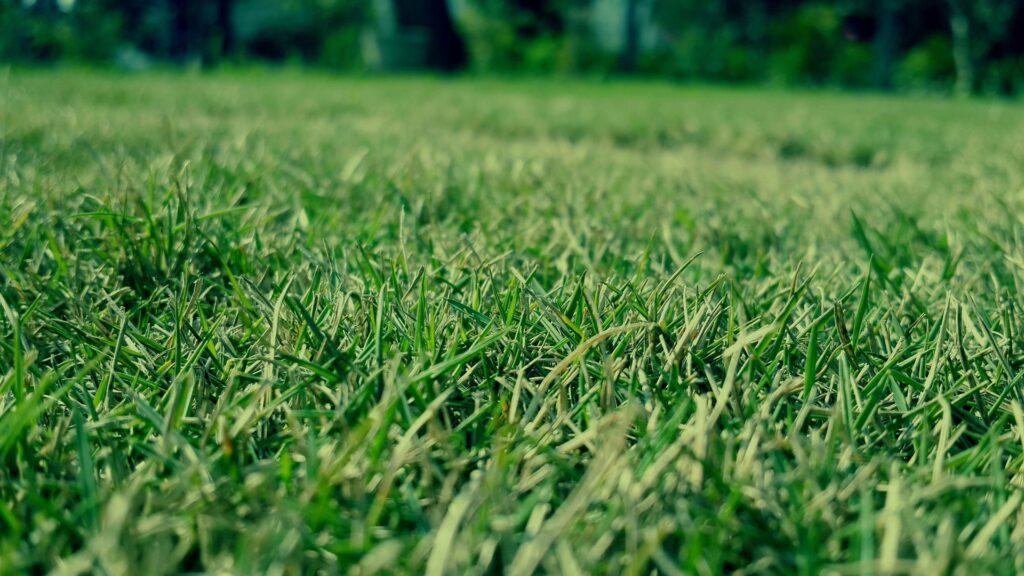
The 9 Most Common Lawn Grass Types
To the untrained eye, grass can just look like grass, and every lawn might seem the same.
For those in the know, you’ll understand that there are many different lawn grass types out there in the US, with some more common than others.
What are the most common types of grass? In the US, some of the most popular grass types include Bermuda, St. Augustine, Zoysia, Fescue, and Kentucky Bluegrass. Depending on the location, certain grass types are more prevalent than others and often categorized as either cool or warm season. Understanding the type of grass you have will make you a better caretaker of it and ensure you get the best growth possible.
Our guide to the common grass types will teach you more about what’s covering your lawn and how to give it what it needs.
Types of Lawns
Lawns are pretty much low maintenance. You only have to make a habit of mowing your grass regularly and applying fertilizer at the right time.
However, for your lawn to thrive, you need to plant the right type of grass seed for your region.
Generally, lawn grass types are categorized into cool-season grass and warm-season grass. The type of lawn you choose will depend on your local climate.
Here are the common types of lawn grass and their descriptions.
Cool-Season Grass

Cool-season grasses are mainly found in cold climate regions, such as the Northeast, Northwest, and Midwest regions of the US.
Popular grass types include:
Kentucky bluegrass
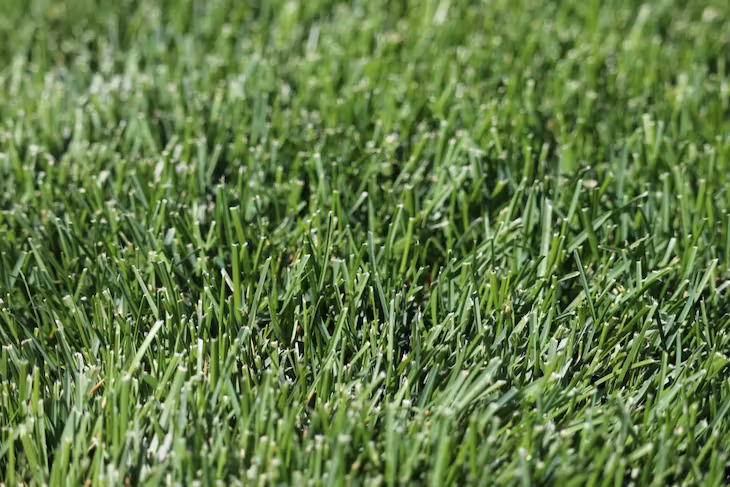
This is one of the most popular types of cool-season grass in most homes, and that’s not unconnected to its reliability and self-repairing capability.
The grass is known to have a robust root system, so it grows rather quickly and strongly, too. The beautiful, V-shaped leaves are soft yet are tough enough to withstand lawnmowers and foot traffic.
It performs excellently in sun and partly shaded areas but the grass won’t do well in heavily shaded areas.
Consider mowing Kentucky bluegrass at a height of 3 to 3.5 inches in summer and 2.5 to 3 inches in spring and fall.
Fine fescue

This grass variety grows very fast but can’t withstand dry or hot weather very much.
Unlike Kentucky bluegrass, this grass variety performs great in shade and produces a lawn with a gentle green appearance. Fine fescue is remarkably soft and welcoming you can lay on it comfortably.
While you can mow fine fescue to a low height of 1.5 inches, leaving it at around 3 inches is ideal.
Tall fescue
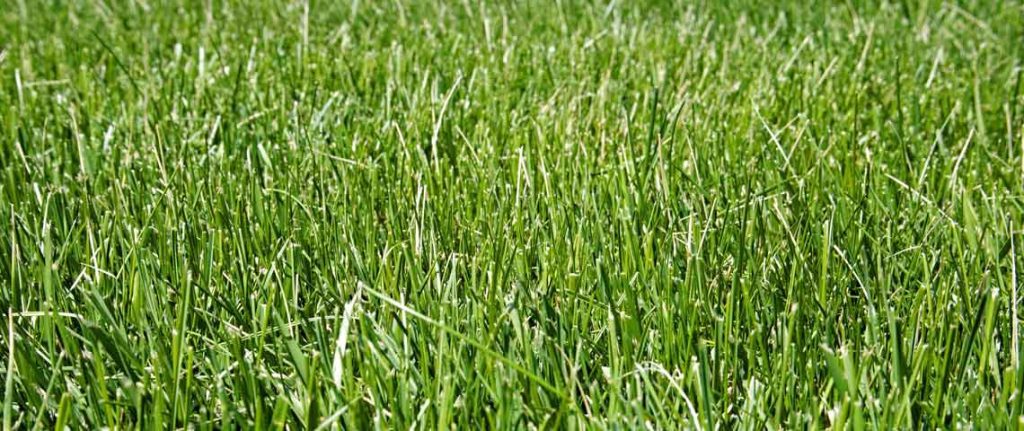
This grass type can withstand dry weather a lot better than most other cool-season grass types.
Its coarse and dark green leaves can stand up to heavy foot traffic and most lawn equipment.
Cutting tall fescue too low can damage it, so keep it at 3.5 inches at the very minimum.
Perennial ryegrass
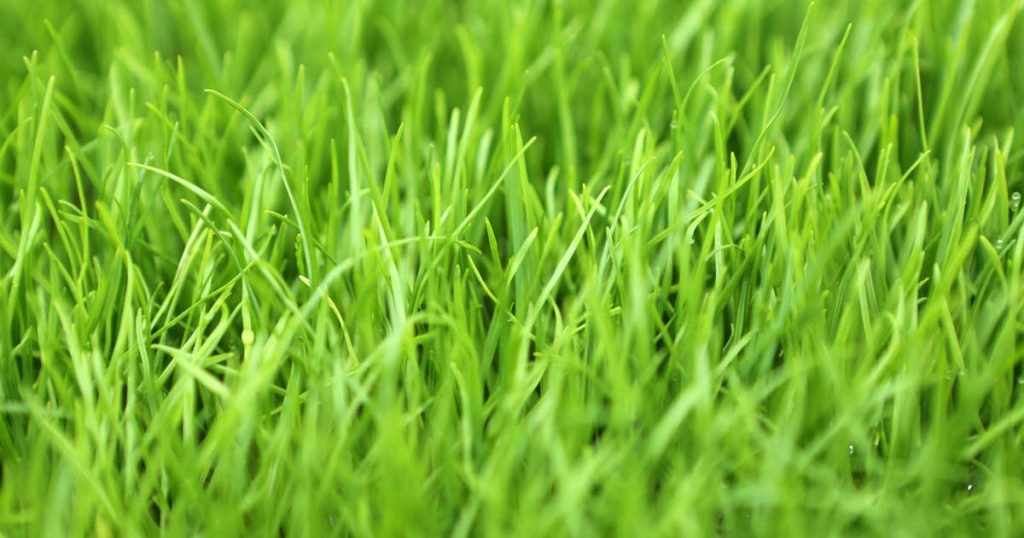
This grass type performs well in both sun and shade. Also, it tends to establish quicker than other cool-season grass types.
Mow perennial ryegrass to a height of about 1.5 to 2.5 inches when the grass is in its active growing phase.
It is usually best to let the grass maintain a height of 2.5 to 3 inches when it is dormant during summer.
Warm-Season Grass
Warm-season grass types thrive better in the scorching sun because they are originally from tropical regions.
These are predominantly found in states with warmer climates, such as California, Arizona, Florida, Georgia, Texas, and other Southwestern states or Sun Belt areas of the United States.
The most popular types of warm-season grass types are:
St. Augustine grass

This slow-growing grass has wide, coarse leaves, and is generally resilient. It can stand up to lawnmowers, mechanized lawn equipment, and heavy foot traffic.
Ideally, you should mow St. Augustine grass to a height of about 2.5 to 4 inches.
Zoysia grass

This is another slow-growing warm-season grass. It has stiff, coarse leaves that thrive in the sun.
In partial shade, mow zoysia grass to a height of about 2 to 2.5 inches. For other cases, a mowing height of 1.5 inches is ideal.
Bermuda grass

The luxurious, thick, and pointed Bermuda grass has a vibrant root system that spreads nicely underground and may even show up above the ground.
This explains why it usually forms dense lawns.
If you have the common Bermuda grass on your lawn, mow it to between 1 and 2 inches. For hybrid varieties, cut the grass to a height of 0.5 to 1.5 inches.
Centipede grass

This type of grass spreads its notched leaves nicely across the ground to create a remarkably dense turf.
Centipede grass has a recommended mowing height of 1 to 1.5 inches.
The Most Popular Lawn Grass Types
Grasses generally fall into two categories: warm-season grasses that do well in warm climates and cool-season grasses that withstand cold winters and drastic temperature changes.
To find out how to best care for the grass you have and which category it’s in, these are the descriptions on the most common types in the US.
#1 Zoysia Grass

Similar in nature to St. Augustine grass, Zoysia is a stiff and coarse type of warm-season grass.
Zoysia is commonly found in coastal areas and is often used on golf courses because of its texture and its ability to withstand heavy foot traffic. It is a fine leaf and has both stolons and rhizomes that allow it to spread assertively.
How to Take Care of It
Zoysia is a low-maintenance grass that’s fairly resistant to pests and weeds because of its aggressive nature. Better still, as a slow-growing grass, it doesn’t need to be mowed as often.
During winter, the grass will go dormant and turn brown but quickly greens up again when the weather improves and the sun comes out.
Watering Your Lawn
It’s possible to overwater Zoysia grass and for this reason, it doesn’t always do well in wet climates. You should provide no more than one inch of water a week to this grass, supplied in one single, heavy soaking.
#2 Bermudagrass

Bermudagrass is a thick and luscious dark green grass that’s prized for its density, making it especially ideal for heavy foot traffic and lots of use.
With pointed leaves and an impressive root system that features stolons and rhizomes, you’ll get tough grass above and below the ground.
Bermuda grows best in the south but has been found in some northern areas, and is classified as warm-season grass.
How to Take Care of It
One of the best things about Bermudagrass is that it’s durable, so you can cut it shorter than most types and it will still bounce back.
For homeowners, that means you can cut your lawn less frequently by doing it short, and reducing the amount of time spent with your lawnmower.
However, it requires a lot of ongoing maintenance to keep it looking thick and green.
Watering Your Lawn
Although durable Bermudagrass requires frequent watering, and more so than many other popular types of grass.
You’ll need to provide between 1 to 1.25 inches of water every week during summer and slightly less in cooler months, or roughly three to five hours of watering.
#3 Fine Fescue Grass

Fine fescue is a cool-season grass that’s known for its fast growth rate and is commonly mixed with other grass types like ryegrass and bluegrass.
The leaf doesn’t do well in hot or dry weather for long periods, but it can withstand temperature changes, and it has thin, pointed leaves with a medium softness feel.
How to Take Care of It
One of the bonuses of fine fescue grass is that it does just as well in shade or sun, and it’s a great choice for planting underneath trees.
Mowing fine fescue is low maintenance as well, and can be done on a more lenient schedule. The grass will stay green year-round as long as it’s cared for.
Watering Your Lawn
Watering schedules for fine fescue will depend on the weather, and during summer and warm periods this means up to three times a week.
Otherwise, a single soaking of around one inch per week should be enough to keep it happy.
#4 Centipede Grass

Known as the lighter green grass with notched leaves, Centipede is another warm-season grass that won’t benefit from living in dry climates.
The grass spreads with stolons which means it grows horizontally across the ground and has a dense look and feel.
How to Take Care of It
If you want low-maintenance grass, Centipede is the way to go. Unlike other warm-season grasses, it doesn’t need a lot of fertilizer and it can even work well with acidic soil conditions.
Because you can mow it quite low, you will be able to mow less frequently but still, keep it in good shape.
Watering Your Lawn
Centipede grass needs a lot of water, especially if you live in a dry climate, and will sometimes require daily watering and heavy soaking.
For this reason, it’s best to choose this for humid or less hot areas, otherwise, the grass can become easily stressed and dried out.
#5 St. Augustine Grass

For warmer climates and for those who don’t mind something a little less soft than others, St. Augustine grass is a popular pick.
This is a slow-growing type of grass that presents with wide leaves and rounded tips, giving a coarser feeling, and it’s extremely heat resistant, even for warm-season grass.
How to Take Care of It
There’s no need to be gentle when caring for your St. Augustine grass. This dense and coarse grass is great for homes with lots of foot traffic and heavy-duty lawn equipment.
Because it’s a slow-growing variety, you won’t need to mow it as often as others, but it still needs maintenance.
Watering Your Lawn
St. Augustine grass requires watering often, but not as frequently as other warm-season types. You should aim to provide ¾ inch of water twice per week with a heavy soaking.
However, it’s also able to withstand heavy downpours makes it popular in areas around the Gulf Coast.
#6 Kentucky Bluegrass

If you look around any cool-season area, you’ll likely find Kentucky Bluegrass growing.
The popular grass is known for being healthy, dark green, and highly resilient, all the while being soft and cushiony to stand on.
The root system of this bluegrass features underground rhizomes and it’s capable of repairing itself, so it can truly do it all.
How to Take Care of It
As one of the most self-sustaining grass types, Kentucky Bluegrass is one for low-maintenance people. Using harsh lawnmowers won’t damage it and it does well in sun and partial shade.
During warmer seasons, mow it once a week, otherwise once every few weeks will be sufficient.
Watering Your Lawn
Kentucky Bluegrass should be watered once a week when it’s hot to prevent it from drying out. During dormant periods, you can stop watering your grass as often, only giving it light water every fortnight.
#7 Tall Fescue
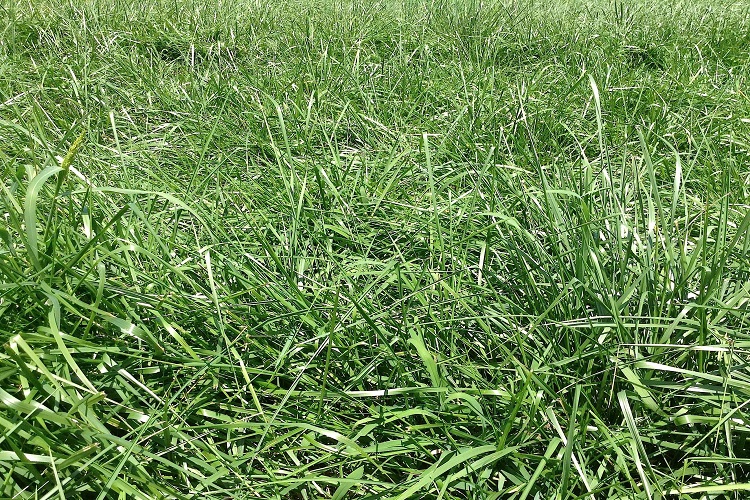
For the perfect mix between a cool-season grass and one that can withstand hot, dry weather, look no further than Tall Fescue.
This grass type has thick, coarse leaves of dark green and sometimes grows in thicker bunches across the lawn.
How to Take Care of It
Tall Fescue is resilient and durable, so you can attack it with heavy machinery, lots of foot traffic, and lawn equipment without worry.
This grass will need to be mowed every 10 days in warm weather but can be left for weeks at a time when the temperatures start to drop.
Watering Your Lawn
Give your Tall Fescue lawn access to around one inch of water a week, either by watering it or letting the rain do the work.
In the colder seasons, this can be reduced to once a fortnight and when it’s really hot, you’ll want to increase the watering to two or three times a week.
#8 Perennial Ryegrass

Perennial Ryegrass is another cool-season grass prized for its ability to become established a lot faster than most. This grass type grows with thin and soft leaves, with pointed ends, and feels luxurious under your feet.
How to Take Care of It
There is some extra work required with this ryegrass because it tends to grow in clumps, which means you have to fix patchy areas and cut down overgrown parts.
Otherwise, it should be mowed as regularly as other cool-season grasses and can be left for weeks at a time during winter. Experts recommend fertilizing this grass once a month as well.
Watering Your Lawn
Perennial ryegrass should be watered frequently, and up to three times a week with a heavy soaking during the warmer months. When it gets cooler, you will still need to water it once a week to keep it in good health.
#9 Buffalo Grass

Buffalo Grass comes in both warm and cool-season varieties and the broad-leafed type of grass is popular across the US.
The low-growing leaf is spread by its stolons and there are new variations that include non-allergenic properties and those that feel luxuriously soft on your feet.
With so many types available, you’ll need to assess the exact Buffalo your home has to care for it properly.
How to Take Care of It
Depending on the type of leaf your Buffalo Grass is, you may need to mow it once every seven days, and every two weeks in spring.
Although relatively easy to maintain, you should fertilizer it every couple of months to help it retain its famous green color.
Watering Your Lawn
Buffalo Grass needs a lot of water and you can expect to drench it up to three times a week during the hotter months.
During winter, there’s no need to water the grass usually, otherwise, it may need a light sprinkling every month or so, depending on weather conditions.
Related Questions
Achieving the lawn of your dreams is no easy feat, as there’s a lot that goes into taking care of it.
If you’ve been trying to boost the growth of your grass and want to know how to do it, we’ve answered some commonly asked questions that will help you do just that.
Should You Compost Your Lawn?
Spreading compost onto your lawn, or top dressing with compost is a great way to improve the soil structure and promote better growth of the grass.
The aim is to spread it over the grass by flinging in but without smothering the grass blades, and then rake the compost in gently.
How Short Should I Cut My Grass?
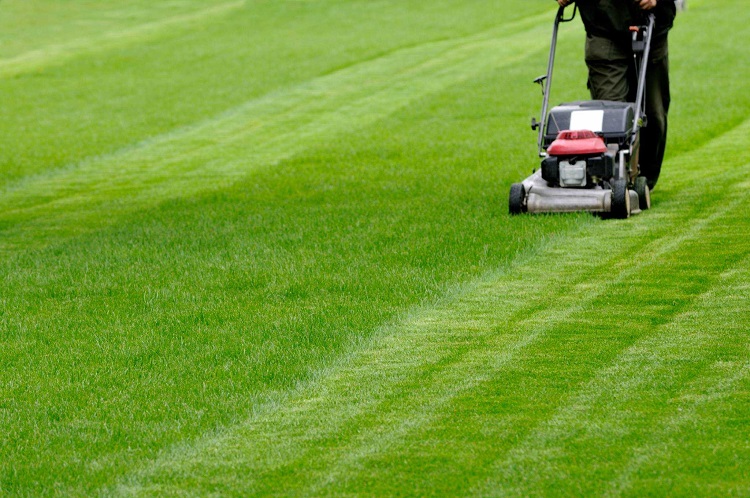
To assess the right length of grass to cut, aim for a height of no more than a third of the total length of the grass blade.
Regular upkeep and cutting every two to three weeks, depending on the weather and its growth, will ensure the grass is kept at the right level for it to be mowed effectively.
How Do You Revive a Dead Patch of Grass?
To revive dead grass, first, rake out the dead patch to remove any debris or weeds and then aerate the lawn and loosen the soil.
Scatter new grass seeds to match the existing grass and then fertilize the ground, watering it daily until it’s matured.
Resources:
